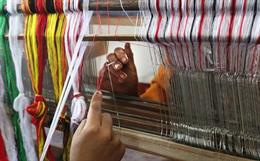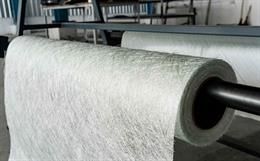A major theme at the Techtextil 2024 trade fair, which takes place in Frankfurt, Germany, from April 23-26, will be the urgent need to establish textile recycling hubs throughout Europe, along with the rapid development of new digital sorting and preparation technologies to enable them.
As previously reported by Fibre2Fashion, new legislation is demanding this, beginning in the European Union (EU) from 2025, when the problem of garment waste will be proportionately thrown back at the brands putting their products on the market.
From 2025, over seven million tons of waste textiles are being mandated to be separately collected each year within the EU and will be paid for by the brands via the introduction of a new Extended Producer Responsibility (EPR) scheme.
This will create a 32 million-ton mountain of new waste by 2030 without very urgent action.
Shredder Waste
Depending on their end-use application, technical textiles could fall under different EU legislation. In July 2023, for example, the European Commission published its proposal for an End of Life Vehicles Directive that will mandate the reuse, recycling and recovery targets for plastic and fibres from the more than six million vehicles that are scrapped in the EU each year.
What currently happens to such waste is far from ideal.
In many instances, metals, tyres and glass currently account for 80-90 per cent of the materials from end-of-life vehicles that are recycled through traditional mechanical recycling streams, while the other 10-20 per cent is rather tragically referred to as ‘automotive shredder residue’ (ASR). This consists of mixed plastic and other non-recycled materials that today generally end up in landfills or are recovered through waste-to-energy technologies – including the many technical textiles employed in vehicles such as interior surface fabrics, insulating materials, filters, cords and belts.
Recycling ASR
Although in a more circular economy, all of these materials would never have got to the stage of being mixed and shredded in the first place, even ASR can potentially be given a second life, and this was the aim of chemicals major Eastman, working in a 2023 project with the United States Automotive Materials Partnership (USAMP), the automotive recycler Padnos and global automotive interiors supplier Yanfeng.
In this project, Padnos, headquartered in Holland, Michigan, supplied a plastic-rich fraction of ASR as a sustainable feedstock for Eastman’s carbon renewal technology (CRT).
Eastman has subsequently demonstrated the conversion of the ASR feedstock into a synthesis gas (syngas) which is then used downstream in the production of its polyester and cellulosic thermoplastics.
Resins from this production process were further formulated and then supplied to Yanfeng and moulded into demonstration components meeting the requirements of OEM vehicle manufacturers Ford, GM and Stellantis, demonstrating proof of concept for a truly circular solution.
The study proved the feasibility of Eastman’s CRT, which breaks down the plastic-rich ASR into molecular building blocks. By recycling these complex plastics into their monomers, the company can replace fossil-based feedstock and create polymers without compromising performance, for use in new automotive applications.
This is a pragmatic potential solution to an existing industry practice, but the practice itself will certainly have to eventually change as the circular economy moves forward, since many suppliers of automotive components, including those based on technical textiles and nonwovens, are now going to great lengths to incorporate recycled and recyclable fibres into their products, in addition to engineering monomaterial-based combinations of composite structures.
Floorcoverings
Eastman is investing around $2.25 billion in molecular recycling technologies that can consume hard-to-recycle waste and turn it specifically into new PET polyester resins for fibres and filaments that are indistinguishable from their fossil-fuel based equivalents.
Its first recycling plant, based on a process called methanolysis, is already operational in Kingsport, Tennessee, where the company is headquartered, and will have a capacity of 110,000 tons when fully ramped up.
The company is currently partnering with automotive OEMs, tier 1 suppliers and polyester spinners to establish supply chain routes for waste as its feedstock for the new plant, including tufted automotive interior carpets.
These products have a four-layer construction consisting of the face layer, primary backing, an adhesive layer and a secondary backing. Until recently, they have been dominated by polyamide structures, but a shift is now underway to polyester due to lower costs and a better sustainability story, both in terms of LCA (life cycle analysis) studies and recycling potential.
Monomaterial
An Eastman tier 1 partner is now producing monomaterial tufted carpets using BCF PET yarns, PET/CoPET nonwoven backings and a PETG adhesive, with a specified 50 per cent recycled content. In establishing a circular system for series production, the calculation is that Eastman would take back 6 kg of carpet trim and scrap from the production of each carpet, and then 14 kg from the vehicle at end-of-life – although the two collection systems will, of course, be many years apart.
Even with such a monomaterial construction, recycling is not straight forward.
“The polyester family is based on the reactions of acids and glycols and not all polymers are the same,” said Eastman market development manager Anders Ludvigsen. “As modifications increase, so do the recycling challenges, and additives, colourants and finishing treatments add further complications.”
Eastman’s molecular recycling technology extracts the monomers MEG and DMT from the PET polyester while removing the contamination that cannot be eliminated by mechanical recycling.
Household Carpet
There is a similar difficulty in recycling conventional household carpets, since they are also generally composites of different layers and often contain latex and other backings, making them difficult to take apart.
Manchester-based Carpet Recycling UK (CRUK) now represents 80 per cent of the UK’s carpet industry, including manufacturers, distributors, raw material suppliers and contractors, allowing it to identify and co-ordinate many recycling opportunities and establish new supply chains.
CRUK has calculated that around 467,000 tons of textile-based carpets are discarded each year in the UK alone, with around 60-70,000 tons recycled and the remainder going to incineration or landfill.
“We are now seeking more engagement with the construction and facilities management sectors in order to further reduce textile flooring waste such as commercial broadloom carpet, carpet tiles and underlay,” said CRUK manager Adnan Zeb-Khan. “As a not-for-profit association we are in a strong position to represent the sector when it comes to discussions on favourable government policy outcomes.”
Many key CRUK members are taking voluntary producer responsibility for the products they place on the market and striving to reduce waste in production, as well as for their customers, helping to create cost savings, Zeb-Khan said.
He added that the ultimate aim is to move carpet and textile flooring up the waste hierarchy in the UK and create circularity to maximise the use of these resources.
“Obviously, preventing this material becoming waste by reusing flooring in new settings is the best outcome for unwanted and surplus material,” he said. “This helps to provide affordable flooring for social housing tenants and low-cost flooring for property developers.”
Key to CRUK’s work is collecting accurate data on the volume of carpet and textile flooring placed on the market together with tonnages for waste material which is being diverted from landfill. One problem it is experiencing is that there is no unified take back scheme for carpet that everybody uses, but this is something he is sure will have to be developed, with EPR potentially coming down the line.
While succeeding in increasing recycling, CRUK believes it is missing out on a lot of material that is getting lost in the very complicated waste management world.
Zeb-Khan put the potential cost of an EPR scheme being imposed on the carpet industry in the UK at around €65 million (approximately $82.67 million), with an additional €30-40 million (approximately $38-51 million) in associated costs. He added that EPR was already in place for electronics, but the consumer is now so used to this, it goes unnoticed.
“The UK government no longer wants to pick up the cost, so duty of care has to stay with the manufacturer,” he said.
Para-Aramid Fibres
The use of high value fibres in certain technical textile end-uses is certainly an advantage when it comes to making their reuse immediately financially valuable, and a good example of an already thriving circular technical fibre business is General Recycling, which was formed in 2012 and has established a complete closed loop system for the recycling, spinning and resale of para-aramid fibres in Quebec, Canada.
High value para-aramid fibres are used extensively in advanced protective workwear and are 5-6 times as strong as steel and inherently flame resistant. They are also 100 per cent non-degradable and cannot be incinerated, so if not recycled they inevitably end up in landfill.
“We partner with end-users in the oil and gas and other industries to take back garments at their end of life, and also take back waste from garment manufacturers,” explained General Recycling sales manager Dave Kasper. “Everything but the zippers and snap fasteners from the collected uniforms is shredded back into fibre.
“We purposely built our facility in Quebec to handle para-aramids, which cannot be handled on conventional recycling machines because they eat machinery – they will grind down shredding drums and carding systems to nothing, in no time. If you can handle para-aramids, you can handle anything else.”
Once converted back into fibre, he added, the company can decide how its yarns are spun and blended with virgin fibres in a number of different counts. The yarns are then sold to knitting or weaving companies.
“Everything we put in the marketplace can be recycled repeatedly, so everything we produce we want back,” Kasper added. “All of the yarns we produce are third-party certified to minimum arc flash and flash fire standards. In many instances, our recycled yarns perform better than virgin products on the market for specific applications, even though they can never be as strong because we are shortening the staple. We have established a closed loop, cost-effective programme and we have patents on both our process and products.”
Carbon Composites
Carbon is another extremely high value fibre, yet of the 60,000 tons of carbon fibre composites produced annually worldwide, only around 1,000 tons is currently recycled.
Increasing carbon fibre recycling is the aim of Gen 2 Carbon, based in Coseley, UK, which employs a pyrolysis method to remove the resins and other impurities from waste composites and converts the recovered fibres into high performance nonwovens. Its current recycling output is an annual 200 tons of carbon, which it expects to increase to 1,000 tons in the next 3-4 years.
A challenge for the company, according to managing director Mark Hitchmough, is getting industries to understand the value of recycled carbon as a resource compared to simply buying more virgin fibre, which is both very expensive and highly energy-intensive in its production.
“A big driver for us in the coming years, however, is likely to be the growing imbalance between the global demand for carbon fibre and actual production,” he said.
Growth in the use of carbon fibre composites is being driven by light weighting in markets including wind turbine blades, hydrogen cylinders and automotive and aerospace projects, with demand set to double to 120,000 tons in 2030, and to double again to 240,000 tons by 2040.
“New capacities would not be able to meet this demand, which means the price of virgin carbon will increase dramatically, which will surely drive progress in the recycling of waste composites,” Hitchmough said.
Glass Fibres
While glass fibres have much lower value than carbon fibres, the recycling of glass fibre composites is currently being investigated in a UK project.
The Emphasizing Project has received funding from Innovate UK and involves Blackburn-based B&M Longworth and a number of industrial partners and the Brunel Composites Centre at Brunel University in London.
It is currently assessing, processing and analysing materials from wind turbine blades, as well as automotive and marine parts, to create roadmaps for recycling. The aim is to demonstrate the feasibility of fabricating automotive end products from upcycled glass fibre materials, including a technical step change from established processes such as pyrolysis and solvolysis with B&M Longworth’s Deecom pressolysis technology.
The Emphasizing Project claimed the JEC World 2024 Innovation Award in the Circularity and Recycling category, ahead of the Composites Show which took place in Paris from March 5-7.
Pressolysis
In December 2022, Longworth succeeded in passing the first stage of acceptance in having its pressolysis process defined as a new recycling methodology by the British Standards Institute (BSI).
The BSI now defines pressolysis as: the reduction of a material to its plasmic state using pressure: a known scientific term normally aligned with biology and referring to a method of testing pressure within the cells of the lungs.
“In this process we add heat and swings of pressure to interact with the polymer in question and achieve the desired result without engaging the original component or fibre, thus reclaiming near-virgin quality materials,” explained B&M Longworth director Jen Hill. “Our Deecom patents are for the process, not for the machinery that houses it, and this frees us from the constraints of shape, size and design and means that each unit built is slightly different and bespoke to the customer. Units are specified based on customer need – throughput, format, volume, material, preferred output, feed system etc – and can range from a desktop structure to very large machines.”
The pressolysis process enables the high-yield reclamation of high-quality, clean, reusable fibres that are free from residues and have a retained length and properties equivalent to virgin materials.
Within the Emphasizing Project, the recovered, clean fibres are subsequently being upcycled through resizing. It is hoped that through finding several use cases for the resized material called ‘glasene’, the industry will gain access to a brand new, advanced material that would be on-shored in the UK and readily available at a low cost.
GFRP
Glass fibre reinforced plastic (GFRP) makes up the majority of the global €54.5 billion ($68.61 billion) composites market according to AVK, the Federation of Recycled Plastics based in Frankfurt, Germany, and the construction, infrastructure and transport sectors are large-scale users, accounting for 70 per cent of the one million-plus tons of GFRP produced annually in Europe alone.
In addition, the wind energy sector is expected to decommission 40,000-60,000 tons of composite wind blade material over the next two years, further adding to the amount of GFRP waste.
Workwear
Also targeting technical textiles for workwear – albeit those based on lower value conventional fibres – Renaissance Textile is a new mechanical recycling plant established by Klopman International and TDV Industries in France. In theory, the business has some immediate advantages when it comes to the supply of its waste input materials, yet still also sees sorting as a major obstacle.
The Renaissance plant aims to achieve significant energy savings while localising the supply chain for workwear fabrics in Europe, which is currently 85 per cent dependent on non-European countries.
Klopman is establishing agreements with clients to take back and recycle workwear at the end of the first life cycle, enabling the production of new fabrics made with an increasing amount of recycled fibre which can be put back on the market.
A key part of the project is the advanced Andritz Laroche recycling technology which has been installed for Renaissance in Laval, France, where the garments are being grouped and sorted and then transformed into new raw materials.
Targets
According to Klopman’s marketing manager Thomas Sieber, Renaissance has set annual targets that will see it recycling 3,000 tons of fibre in 2024 and 12,000 tons by 2026 – allowing the annual production of 42 million new garments when fully operational.
At present, the plant is recycling white and unbleached cotton and polyester waste clothing and by 2025 anticipates accommodating coloured textiles too.
“Our business today is 98 per cent workwear, with a focus on fabrics that fit the needs of the global workwear rental industry,” Sieber explained. “Renting and industrial washing is a completely different concept to retail. With rental we are talking about the lifetime of the garment and total cost of ownership which demands a completely different approach both to the design and the product itself.”
Going Circular
Rented workwear has to endure between 50- 100 wash cycles in industrial conditions over its usable life.
“We have partners washing in 300 kW machines with a lot of chemicals and a lot of loading, putting tremendous pressure on the fabrics,” Sieber said. “So, when we are talking about circularity, whatever we do, our fabrics need to have the same performance level as the original virgin product at the minimum. Everything we make is performance driven and that is the reason we cannot have any compromises, since it would kill the basic rental concept.”
In 2018 the partners started to work with Andritz and developed a mechanical recycling concept enabling the full end-of-life garments to be loaded into the tearing machine, automatically separate the hard and soft parts, and get out a fibre that can be reused again in the spinning and weaving processes.
“Our customers renting workwear know what the cost of a bib-and-brace uniform was 25 years ago and also what it should cost tomorrow and the day after, so we have no chance to make higher margins, meaning the recycling has to be cost efficient,” Sieber said. “This can only be achieved with a high degree of automisation and a high degree of the utilisation of the feedstock for the process. Already, from 1 kg of an end-of-life garment, we have been able to obtain 85 per cent as reusable fibres and everything else is the hard waste.”
He added that the laundry industry is in itself operating in a circular way.
“This is an absolute advantage in terms of logistics and how we can bring back the garments, compared to the challenges the retailers face,” he said. “Laundry garments are not sold directly to consumer markets and come back every week to be washed and serviced and repaired, so a laundry company is naturally interested in a long lifetime and durability, because whenever a garment is no longer usable, they have to replace it. If a garment continues to be used for three years instead of one, that is gross margin and profit at the end of the day.
“The bad news is that these laundries know everything about the products when they are in service, but have no interest once they pass that point, so one of the keys in the future for us is in the sorting process – how clean we can make the feedstock for recycling. This will be one of the biggest investments for us in the coming years and represents one of the biggest challenges to the industry as a whole.”
Conclusion
The need to establish viable recycling supply chains for all textiles will become increasingly important in the next few years, driven by legislation.
Unlike conventional apparel, however, technical textiles often have applications within industrial environments. This means that in many cases their collection for recycling will not simply be reliant on general consumer compliance with separate collection bins.
The known supply chains and end-use destinations of such materials should also in theory make their traceability much simpler.
Industry is now taking responsibility for establishing end-of-life textile-to-textile recycling solutions in areas such as workwear, geotextiles, transportation materials etc.
The high value of many fibres employed in technical applications such as carbon, aramids and high performance polyethylenes adds a further impetus to a number of these initiatives.







